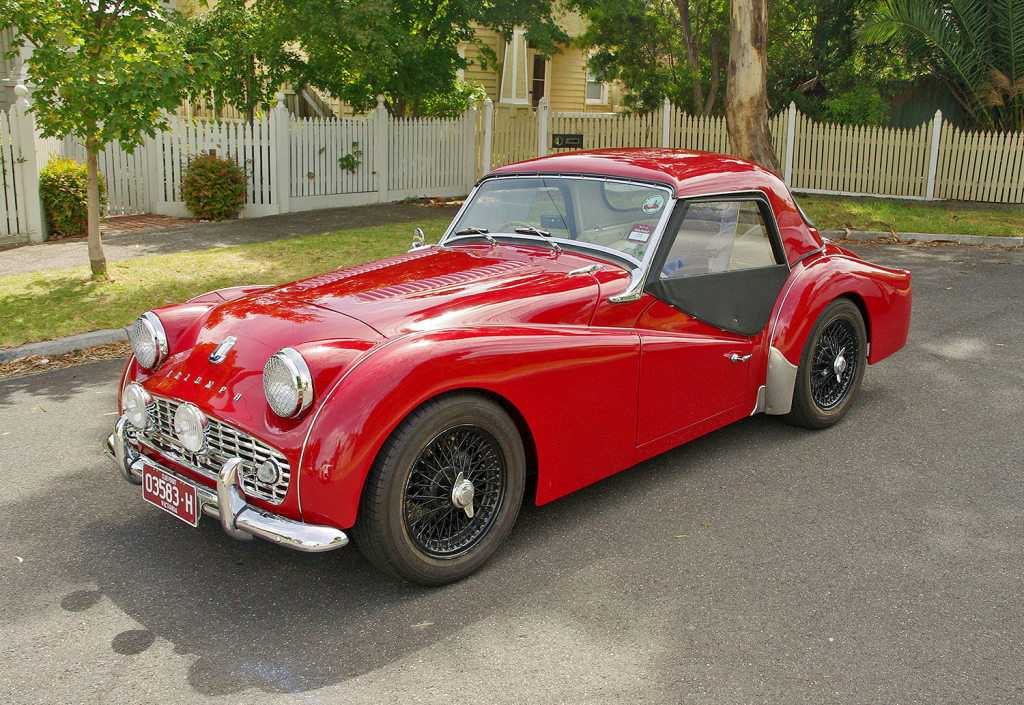Vehicle Model: TR3A Year: 1960 Commission Number: TS 75246 O
State: Victoria Owned since:
The Restoration Story
The early history is mainly unknown, however a couple of years ago I was speaking to Keith Brown, a current TR 3A owner, and member of the TR Register in Melbourne, who told me he was the second owner, and had the car for two years, when it was only a couple of years old. Shortly after my purchase, I was talking to Ray Delany, whom I knew, from my Austin Healey days. Ray told me he had owned a 3A when he was 19, and mentioned it’s rego no, HFA-443. He still had lots of invoices from his ownership, which he later gave me, and was interested to know where his old car was. I think he was surprised that I now owned her. There are many missing gaps of ownership, which I would like to solve. VIC Roads/AOMC do not keep names on file, and would not release them if they did, so I hope someday I might gather more information. I bought HFA from John Gove, 14th July, 1991. John bought it, along with two other, 3A’s, 7 years previously, from someone who had collected the three cars some 6 years before. Both had the intention of rebuilding one out of all the parts from the three cars. John had started on one, but decided on another project, and put all three cars up for sale. HFA was partially dismantled, and had not been worked on, but I was assured it was “nearly complete”. Oh how much was missing I was yet to learn!!! However I did get a trailer load of parts in the deal, many were duplicated, others required, were missing.
HFA was in a reasonable, but tired condition, but a good basis for a total restoration.
My mission was to rebuild and restore the car to the highest standards of finish that I could achieve. I am not that into Concours competition, but it was important to me that second best was not what I wanted.
HFA had obviously had a hard life, and at some stage suffered some rear and frontal body damage. The tub, doors, boot lid, rear guards, front apron, and bonnet were original to the car. The engine, gear box and overdrive were matching numbers for the Commission plate number, the rear end was out of a TR 4, (wider track),and was thus replaced with a correct Girling back end which came as a one of the spares.
There was minimal rust in the tub; however both cockpit floors, boot floor, inner and outer sills, both sides, were replaced during the body rebuild. The engine turned over by hand, a good beginning. Gear box and overdrive, unknown condition. There were no carburettors, radiator doubtful, interior trim sad, but mostly there, which was bone coloured, later handy when ordering a trim kit from John Skinner in the UK. The seats were present with sound metal, the right hand drive dash still in place. Amongst all the boxes of bits that came with the car, I found all the instruments except a water temp gauge, later sourced.
HFA’s last registration expired in 1974, according to the label on the windscreen, with an indicated mileage of 81540.
Ignorance might be bliss, but two years before I had bought Brian Richards lovely 3A, his first one, so I had some awareness about TR’s. My plan was a complete restoration, doing as much of the work myself, but recognising my own limitations. Like so many others who have embarked on such projects before me, I had set a rough financial budget, and a time frame of about four years, but, we always seem to under estimate these things, by a long way in my case. I had reasonable experience in rebuilds, my first, an MG TC, then a MK 2 Cooper S, a Super 90 356 Porsche, all involving mechanical, painting, assembling, detailing. I should have undertaken a panel beating course many years ago, but didn’t, so I left the panel work to a specialist, Mike Larkman, who does brilliant work.
When I purchased HFA, our house had plenty of garage space to store the car and parts. With other family priorities, the project did not commence till the beginning of 2001, by which time we had down sized our home. The 3A went into paid storage for 3 years, after we moved. I was having so much enjoyment with my first 3A. Anyway there was not a great hurry to get started. Early on I had made a list of all the parts that I could see were missing. During the following years, I began to tick off the list, (but also adding more as missing items became apparent,) as I acquired either new or second hand parts. It was my plan to have as many parts as possible before I started the project. Over the life of the restoration, I think I must rate as one of the Register’s best new parts customers!
Having relocate HFA to our new house from storage, I lifted the body off and placed it complete on a pair of trestles, leaving the rolling chassis to be dismantled. In a short time, I had the engine and gear box out, all the front suspension off, the rear end removed, brake, fuel lines and hand brake cables out, leaving a very bare but dirty frame. There was evidence that the left hand front tower was bent, and many dents in the underside of the frame from jacking marks. I purchased an undamaged frame which was sent to Andy Ansell to check and repair any cracks, and to weld in brackets for a front sway bar. I had been advised to have the chassis gusseted as per the factory works rally cars, which Andy did. The frame was sand blasted and then powder coated gloss black, and came back looking very smart. I must say that working on clean components is to my liking, but there was much cleaning to go along the way. The body and all the panels, including a second bonnet which I had had two rows of 20 louvers pressed in, I really like looking at the louvers, were sent for bead blasting, and came back with a protective coating, thus saving Mike Larkman hours of paint removal. With the help of my good friend, David Kelly, we loaded a tandem trailer with the body and all panels and off to Mike. I supplied Mike with new floors, sills, battery box, supplied by KAS Sheet Metal in Ballarat, plus everything else to complete a total body rebuild.
Mike has performed a near miracle on what was presented to him. At one stage I visited Mike’s works to see the body in THREE separate sections. The damage to the tail was worse than expected following some very poor repairs in the past. But Mike’s skills are amazing when one looks at what he has achieved. Over the course of 15 months the body was repaired and painted, an Alfa Romeo red, which is darker than signal red. The quality of the paint work is sensational, the panel gaps perfect. Mike also refurbished a steel hard top that I had bought, and he fitted same to the body.
Meanwhile I started to assemble the chassis. Every part of the front suspension was renewed or reconditioned. The front and rear springs were lowered an inch. I rebuilt the original steering box using a new worm from Moss, new drop arm and peg, new bushes, seals, bearings, while paying particular attention to achieving factory tolerances. New ball joints and tie rod ends fitted. I painted components in polyurethane spray pack. New front and rear shockers were installed.
The rear axle was completely dismantled, checked and reassembled with new bearings, at great cost! The diff was set up. New wheel bearings and seals were installed, and the housing spray painted black. All very straight forward I found, having previously rebuilt the diff on a 100/4 Healey some years before, but time consuming.
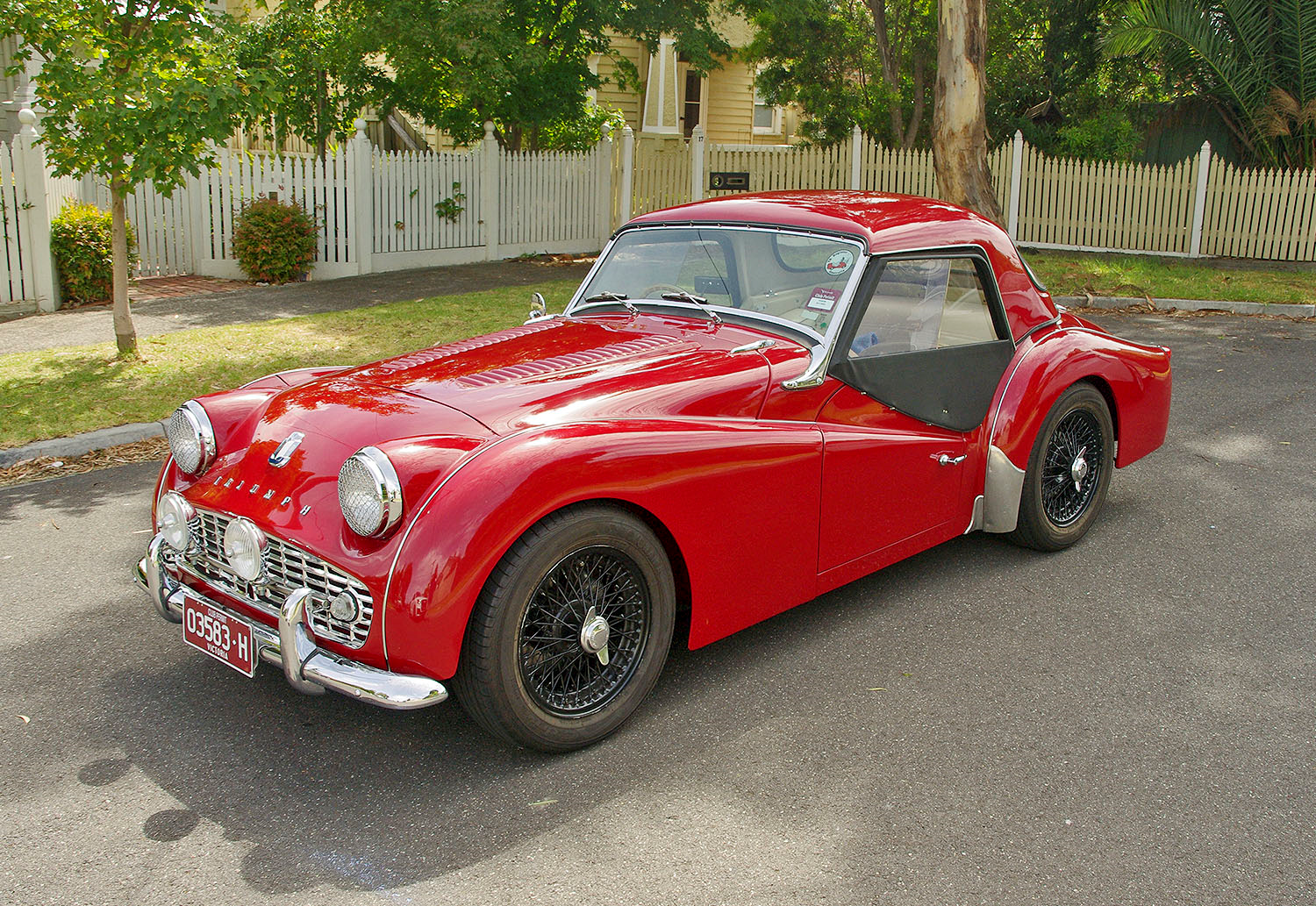
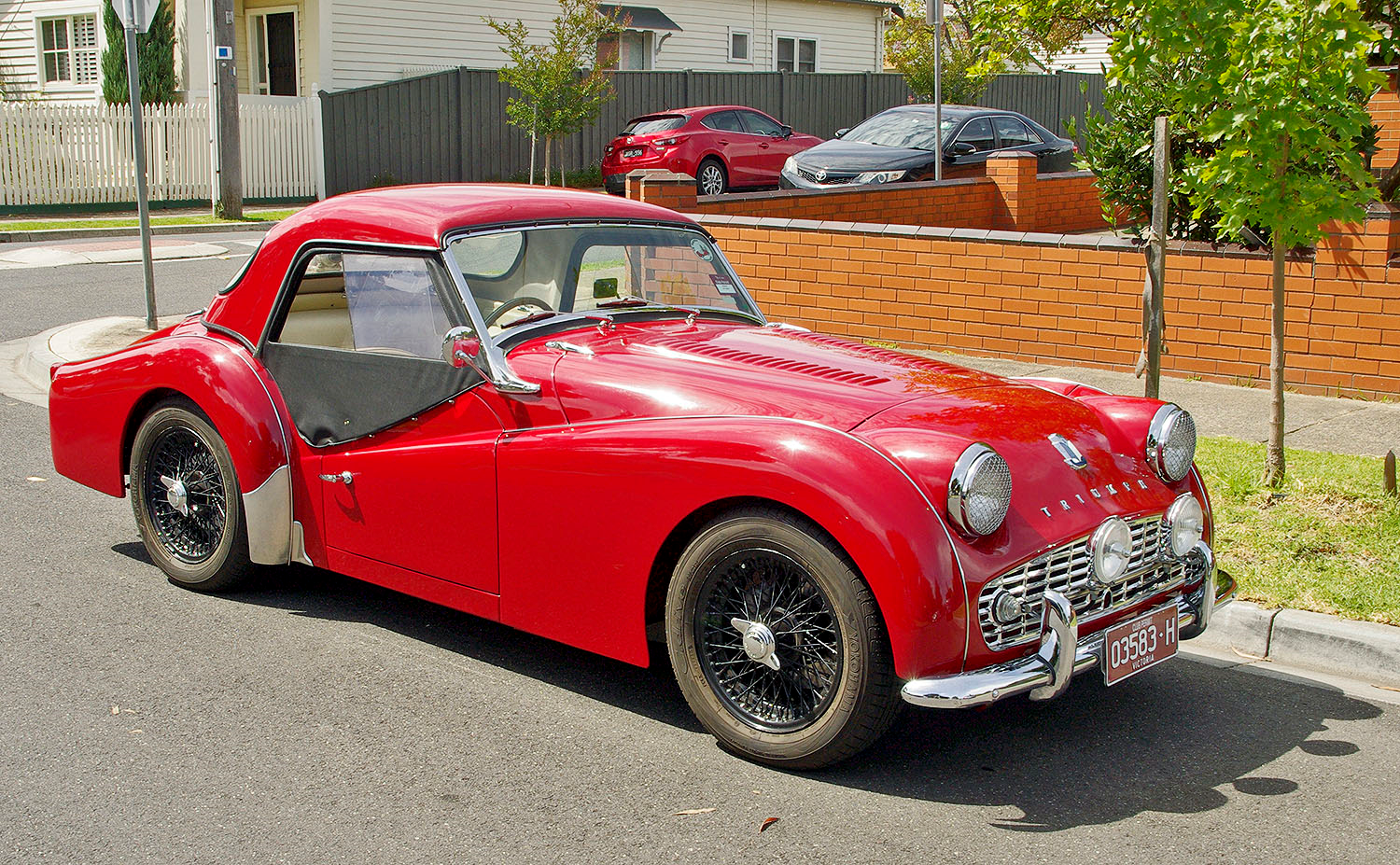
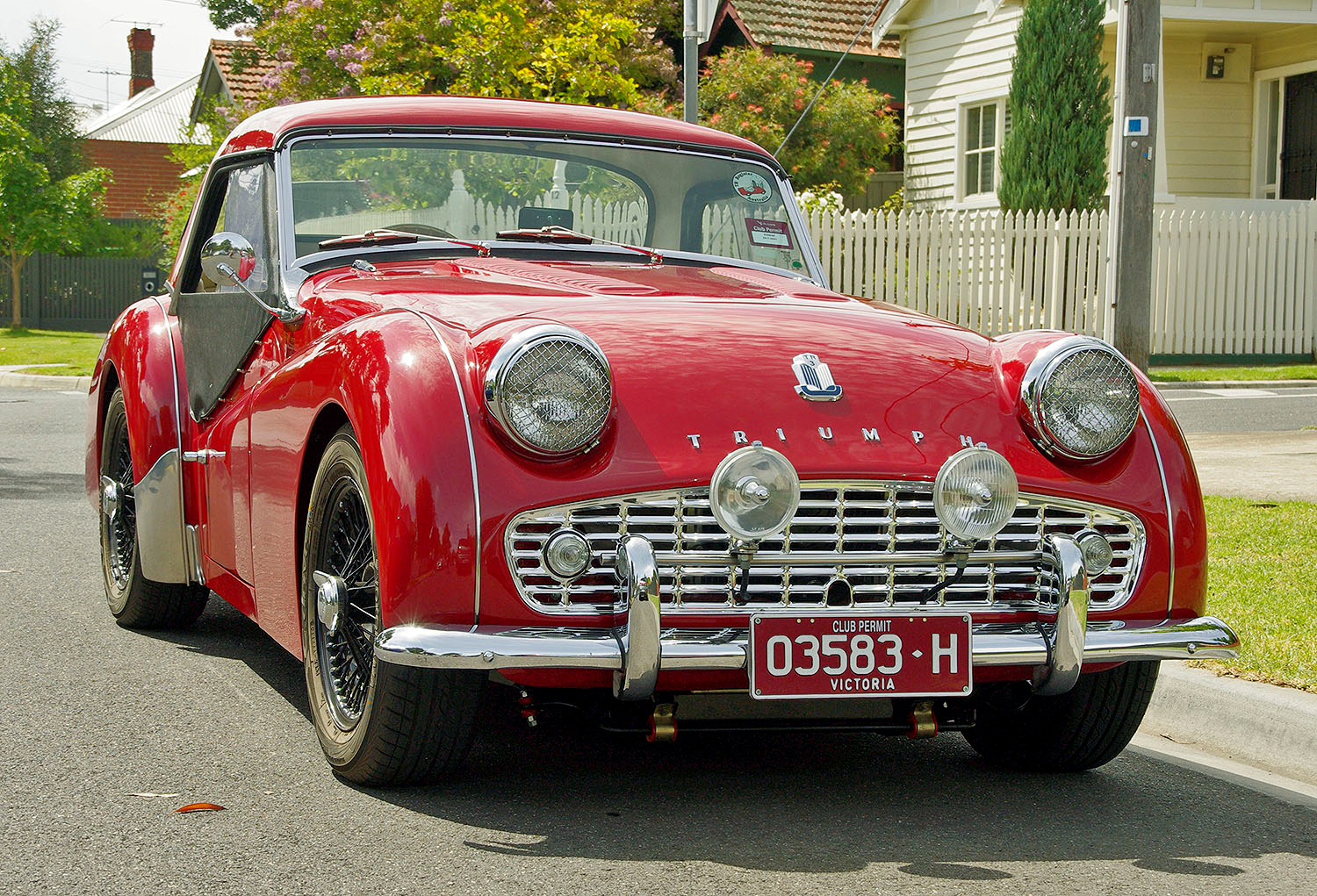
Front callipers were fully checked and rebuilt as were the rear wheel slave cylinders. The drums were machined. New pads and linings installed, and the master cylinder rebuilt, and all brake lines and hoses renewed. BGT in Dandenong do excellent work at reasonable prices. I fitted a PBR 44 power brake booster for good measure.
The engine was the second largest aspect of the rebuild. All machining was carried out by Orger Engines. The block was tank dipped. The crankshaft crack tested and ground 1st undersized, mains and big ends, micro polished, and heat treated. The flywheel lightened, rods sized, the pistons, 87 mm, and liners are Mahle. All moving components were fully balanced. Orger assembled the crank, rods, pistons and liners, into the block. The Cylinder Head. Following crack testing and machining to 9.5 to 1, compression ratio, with new guides and valves, my good mate, Mike Heaton worked the head for gas flow and balancing the combustion chambers. The camshaft was ground to a 30/70 profile, which is a very usable road cam. New timing chain, cam wheels, followers, rocker shaft and bushes, and lightened rockers were installed. I assembled the engine carefully from where Orgers had stopped. The oil pump with a new rotor and spindle and minimum tolerances was fitted. I have stayed with a new wide belt generator set up, but may change over to an alternator in the future. I have not used the original fan, but left the original extension on. I run an electric fan, with a thermostat and a manual switch. Belt and braces. The distributor is as original, but new, having been graphed to the cam specs. (I recently changed to an Electronic Distributer).I am using 1 ¾ SU’s on a log type manifold matched to the head, and original air cleaners. Early in my ownership I bought a new old stock set of Sonic extractors, which I had hot coated in silver. The starter is a Lucas type, but I may change it over to a high torque one in the future. While I was working on the engine, Geoff Kelly rebuilt the 3 synchro A type gear box and overdrive. With the clutch, new, the engine and gear box were mated, and installed onto the chassis with the help of David Kelly, very easy, when the body is off. The tail shaft, fitted with new uni’s, balanced, painted, was installed. I had a rolling chassis which I took to Mike Larkman to fit the restored body. When I collected said body and chassis I felt I was getting somewhere, but in reality it took another 3 years to finish the car.
With the car back at home, I commenced the clean work of wiring, refitting the steel dash panel, installing the heater, and steering column and support brackets, and under dash bits. All the instruments were restored by Ringwood Speedos. Fortunately, I had anticipated that they would take some months to do, but the wait was really well worth it. They look like brand new. The new loom took less time than I expected to install, and was very rewarding as I tested each electrical unit to find it worked. Well most of it did first off!
Every chrome component was either replated, or replaced with new parts. All rubbers items were renewed and the heating system restored, mechanically, and cosmetically.
The third major area was the trimming. I profess that trimming is not a skill I have. I imported a full trim kit from John Skinner in England. The seats are leather, the rest not. I used a local trimmer who came to my garage to do the rear wheel arches. I did the dash, but the cockpit rails, door tops, seats, and lining the hard top, were done in his workshop. The door trims only require screwing to the door frames. Likewise the side panels behind the seats, across the rear of the cockpit, and those next to the driver’s and passengers’ legs, a task I felt confident to do. The black carpet set from Skinners was easy, but time consuming to get right. I am very happy with the interior, which is in a bone colour, as close to the sample taken from what was originally in the car. In retrospect it might have worked out cheaper to have had a local trimmer start from scratch, but one learns as one goes along! The same trimmer also fitted a tonneau and hood purchased from the Register, in case I want to take the hard top off.
I was starting to shorten the list of to- do’s. I had an exhaust system made, which I fitted. From experience with my other 3A, I decided to use an aluminium radiator, not original, but certainly effective. New water hoses, and water pump, of course.
I am using rebuilt 60 spoke wires fitted with 165X15 XZX tyres. Very skinny by today’s standards but correct for the car as I won’t be running HFA in competition as I do with 3A No 1. I purchased new wire wheel adaptors to ensure good splines, and no knocking when you change gear or brake, plus new KO’s.
By this time I had filled out three A4 binders with invoices, receipts, notes, and relevant information. The dollars spent on new rubber grommets, seals, plugs, bolts, nuts, washers, etc is astounding. I have added up the cost of what I have spent on the car, but I am not going to divulge the total as I might incriminate myself on the home front. Let me say it is many times the original budget!!!
All the fluids were poured in. I was recommended to use Penrite running- in oil for the first 300 miles. It was time to start the engine for the first time. All very exciting but I was also somewhat apprehensive. So onwards. I primed the fuel pump and carburettors; hit the starter button, having previously got oil pressure up with the spark plugs removed. Nothing fired up, but at least the engine was turning over without any rude noises. Thinking time! I know the cam to crankshaft was timed correctly, and valves clearances set as per the cam grinder’s recommendation. I rechecked the ignition timing to find it way too advanced. After resetting it, I tried again. Magic, the engine roared into life. The initial 15 minutes is critical to bedding in a new camshaft, so I ran the engine at around 2000 RPM, for 8 minutes, stopped for 10, and then ran it for another 10 minutes. While it was not perfectly tuned, at least it was running strongly. No major leaks of oil, or water.
Because there were many small jobs to finish, HFA was not ready to be driven. I have run the engine for some two hours in total over the months before actually driving the car on the road.
So after nearly 10 years of restoration, and 35 years since last being registered, HFA-443, was issued with Club Permit Plates, number, 03583-H, on the 15the June, 2009. The first drive was about 7 miles, on 3rd September, 2009.
On 25th October, 2009 I went on a TR Register Vic run to Langwarrin, clocking up some 110 miles. I am very pleased with the road performance. The steering is precise, brakes very effective, and with the hard top on, the interior noise is quieter than I expected. The whole car feels very tight with no rattles or scuttle shake.
I did two short runs, the first, into the old AMI building in Elizabeth Street, City, now Lexus showrooms, to display the 3A as part of the cocktail party to celebrate the 50th year of TSOA Vic. Some 50 years since the car was sold from there. The second, to attend TSOA’s Concours 2010, at the Flemington Racecourse.
The second long run was on 16th January 2011, as part of the RACV Great Australian Rally, Melbourne to Mornington. A huge event for older cars, and motor bikes. HFA won the trophy for the Best Late Classic (1940 – 1981), much to my surprise and delight.
I have enjoyed the countless number of challenges, frustrating at times, of returning this 3A to better condition than when she left the factory. I am fortunate to have been assisted by some very clever and experienced craftsmen, together with so much helpful advice from good friends and fellow TR members.
I am very pleased with the end result, which achieved what I set out to do. With the introduction of the revised Club Permit scheme, I can have unrestricted use for up to 45 days per year, so I intend to use the 3A quite a lot, and enjoy the camaraderie of fellow TR Register members as often as I can.
As a side comment, my two 3A’s were both built on the same day, 5 May 1960. My first one is Commission no TS 75195 0, with Body no 1077225., EB : 73227. Something of a coincident, that the two sets of brass plates on the firewall of each car are sequential numbered, should be owned by the same custodian at the same time.
Ross McKinnon, TR Register Australia, Member no 16.
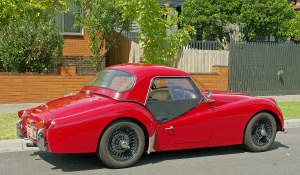

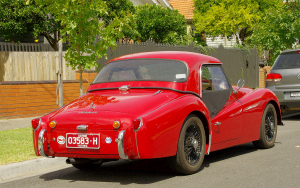
Vehicle Model: TR3A Year: 1960 Commission Number: TS 75195 O
State: Victoria Sold in 2018
History of: TS 75195 0, Engine no TS 75596 E.
Now Club Permit Registered : CH-1465
The birth certificate confirms it was built on 5 th May, 1960. I bought this car from Brian Richards on the 23rd July, 1988. Brian had owned it for some 12 years. During his ownership he rebuilt it to a very high standard, winning the TR Register’s Concours in 1983, and 1985.
The early history is largely unknown, except it was sold by AMI, Melbourne, and first registered as HFG 431, on 10 th August, 1960. I believe the original owner was Charles Foundyler of Toorak, in Melbourne.
Brian told me he purchased it from someone in Canberra, and believed at some stage it was supercharged and raced. The supercharger theory was confirmed in 2010, when I was talking to I guy I knew in my Porsche club days, who said he fitted it for Charles Foundyler, around 1961/62.
I would dearly like to fill in the gaps if anyone has knowledge of this car. (My phone no is (03) 9827 5234). During the last 18 years I have competed in club sprints, and Historic Regularity events, and 6 Hour Relays. Breaking the Crankshaft at the Historic Phillip Island Meeting in March 2004, was the catalyst for a freshen up of the chassis, mechanicals, and some body work. The interior is still in wonderful condition, thanks to the quality of Brian’s rebuild.
The body was lifted off the chassis complete. The chassis was stripped bare, and sent for crack checking, welding in of strengthening gussets, sandblasting, and powder coating.
Meanwhile a second engine was built with much help from my friend, Mike Heaton. The specification was extensive and thorough, and vastly expensive, with all the good bits, but well worth it. The original gear box was replaced by a TR 4 unit which was rebuilt by Geoff Kelly, and mated to the overdrive from the 3 syncro box.
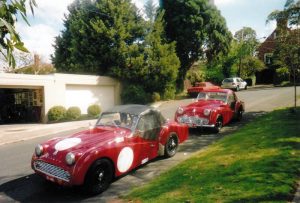
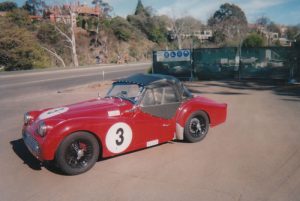
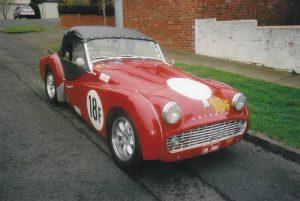
The chassis was reassembled with new or reconditioned suspension, lowered springs, modified TR 4/5 top arms to give negative camber, Koni shockers at the front, standard at the rear, the engine and gearbox refitted, brakes rebuilt , steering components checked, and the body installed.
All very simple, but takes time.
I retained the original steering box which was in perfect order, again thanks to Brian’s good work. Mike Larkman tided up the front panels. Since completion, I continue to compete in Club and Historic events. The 3A goes really well on the track and the road. The original motor awaits a rebuild in the future.
I have owned the 3A longer than any previous car, and just love driving it. With the introduction of the revised Club Permit Scheme in Victoria, I can use it on an unrestricted basis for up to 90 days per year. That is some incentive to take it out of the garage!
Ross McKinnon, TR Register Australia, Member no 16.
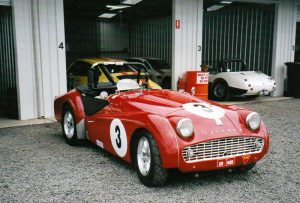
After 2009 Winton Alfa Romeo 6 Hour
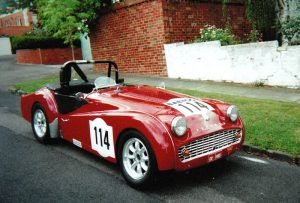
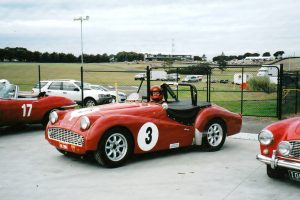
VHRR 2008 Philip Island ‘Ready To Go’

